Carrots are a vegetable, popular in cooking. It gives a dish sweetness. It combines well with other vegetables, meat, fish or fruit. This root plant is not a capricious plant, but errors in care for it are able to lead to diseases, significantly reduce the quality and volume of the crop.
Features of carrots
For a long period of time, people brought a large number of carrot varieties. Initially, the plant was domesticated in our areas as an exotic spice. Seeds and topics used as seasoning.
Carrots, after sowing seeds in the first year, consists of tops and root. Seeds gives in the second year of cultivation. They are formed in umbrella inflorescence. As an agricultural culture, it is divided into species: sowing and cultural carrots.
Carrots are rich in vitamins and useful trace elements. It is necessary for a person to maintain vital activity. Korneplood has a positive effect on vision, contributes to the general strengthening of the body due to the content of vitamins, acids and other useful components.
Carrot varieties for open soil
Breeders are actively engaged in the conclusion of new varieties for different regions. Providing the possibility of varieties well to take effect in cold and hot conditions, adapt to the climate of maturation terms, to withstand parasites.
Depending on the type of soil, the same carrot variety can climb in the root of different shapes: in loose sandstone - neat cones; In solid swimming ground - curved, branched and pointed roots.
A good crop precedes painstaking work on the site and appropriate care. However, it is important to seed seeds for sowing. Many varieties, but let's try to figure out what the features of the most popular of them are.
Morkovi's grades
Carrot varieties are conventionally combined into three categories according to the criterion of the shape of the root plant. This is a cone, cylinder and ball. Carrots are divided into varieties (Nantes, Sharkta, Flacca), which are divided into early, medium and lateral varieties.
Consider the features of each zotto.
Nante:
- leaves small;
- root of the cylinder;
- root crust with a narrow core in the tone of the Core;
- it has early and late satisfying varieties (bright, crown of NATOO, PRIAN, etc.)
Sharcanka:
- leaves fleshy and high;
- korneflood in the form of a cone;
- the core is big;
- has early and late satiety (sweet tooth, artek, red Giant, etc.)
Geranda:
- leaves straight, medium;
- root cone;
- carrot has a grated wide core;
- has early varieties (Alenka and Carotel);
- it is characterized by the duration of storage and an increased content of carotene, useful for sight.
Flycke:
- the moor of weight is equal to the fetus;
- root root, has a rounded form;
- carrot rod wide in diameter;
- it has late satisfied grade (queen of autumn, Helsmaster).
Paris Carotel:
- has early varieties;
- roundplood rounded, small in diameter;
- differs good yield, even in the most difficult conditions.
Amsterdam:
- has early varieties;
- roots in the form of a long narrow cylinder;
- differs to fragility and absolute unsuitability for long-term storage.
Emperor:
- it has medium and lateral varieties (Russian size, mo, sugar farm);
- root cornestode, in the form of a pointed cone;
- fragile zortotype - can break through negligence;
- such carrots can be discharge.
Berlikum-nantkaya:
- a large root of the cylinder with a pointed tip;
- differs good leafiness;
- not so tasty, like a nanntal, or carrot of other solidages.
If you need a carrot, which will save the taste and useful components for a long time - stop your choice on the autumn queen, red giant, autumn red, long red, perfection, etc.
If the result is the result of the highest aging - after 1.7-2 months, it will please the crop nannet 4 or 14, provided if the soil is soft, and after 2 - 2.5 months after sowing, you can eat carrots of Artek varieties, Rex, chanson, vitamin 6 etc.
Early carrots are desirable to eat in summer, or apply in conservation (in salads, marinades, etc.). It is not able to be stored for a long time. It is best for wintering in the cellar approached varieties, the cleaning of which falls on autumn, and the dates of ripening range from 3 to 4.5 months.
Among the carrot varieties have a purple carrot F1 purple elixir, containing special useful substances that contribute to the purification of the body from fats and cholesterol, improve the work of the central nervous system and blood circulation organs.
Features of planting carrots in open ground
To make a good harvest in open soil, you need to carefully approach the soil. The land must be loose, fertile, with neutral acidity and medium humidity. This is important for the quality of the root plates: their forms, taste, health.
Choosing a place when landing of carrots in open ground
- For a fruitful harvest, it is impossible to plant carrots on the same place, or after plants-spices (parsley, fennel, etc.). It threatens infection with parasites (tool, carrot fly, etc.) is best to plant it in areas where the cucumbers, tomatoes, potatoes, beans or grain, changing places of cycle grew up for 3 years.
- An important role in the preparation of the soil plays her fertilizer. The feeding is made at the rate of 1 m square. 0.5 compost or humus buckets. If the earth is sublinous, the looseness will add sawdust. A good fertilizer for carrots is wood ash.
- Forbidden fertilizers: Fresh manure and nitrogen fertilizers in large quantities. They harm the structure and mineral balance of root.
When is it necessary to carry out carrots in open soil?
- It is accepted to plant carrots in the spring, but if there is a desire to get an early harvest from late varieties, you can sow carrots at the end of the autumn - before the onset of snowfall cold weather. It will chase seeds, and in the spring they will go around the call of nature - when it is most comfortable for them. Such carrots are well eaten fresh. It is not recommended to store it in winter - for this, the autumn late crop of carrots planted in the spring is waiting.
- Spring landing of early carrots in open ground should begin with a steady temperature +8. This is necessary in order for abundant moisture to evaporate from the ground to sufficiently. Late-weighted storage varieties should be sown in April-May when the street will be warm.
- Seed germination temperature is about +5 ºC. This means that the sowing work is best to start after a complete warming of the Earth - on the last week of April - early May. You need to have time to sink carrots before the start of the rainy season - moisture and heat contribute to the active growth of the root.
- The preparation of the Earth for the Spring Sowing should occur by autumn - after harvesting. Swimming is performed as deep as possible by adding fertilizers - so the carrots will grow beautiful and rich in vitamins.
- There is a feature of planting carrots under the winter - the result is not possible on each land. For example, loyal soils are painfully reacting to moisture when melting snow - the earth is pressed and becomes gross monolith. Only on light soils are possible to grow carrots with sowing at the end of autumn.
- Saw early carrots in autumn, you need to prepare warm beds. In the second third week of October, the place under the sowing is heated by greenhouses. After 21 days, the seeds are burned into the ground and sprinkle at least 3 cm peat layers (instead you can use sawdust and other mulch). After wintering, when snow is going, bedding under carrots are inspected under the film - they put small greenhouses. It is necessary to follow the appearance of germs: as soon as the greenhouse of carrots appears near the greenhouse, it can be removed and waiting for a harvest.
How to treat carrots seeds for open soil?
Seeds for carrots do not necessarily process in any particular way. But some gardeners try to speed up the process of seedlings, resorting to such tricks:
- Baths. Seeds poured into a ceramic vessel and poured a little warm water for 4 hours. Repeat the procedure 6 times during the day by changing the cooled water to fresh warm. In order to mineral enrichment instead of ordinary water, you can make baths from wood ash solution (1 liters of water - 1 tbsp. Fertilizer). Seeds that have passed all the stages of the procedure are washed, wrapped into the fabric and sent to the refrigerator, which contributes to quenching future sprouts.
- Contrast water procedures. Seeds initially tie into a fabric bag. 2 tanks are prepared: with hot water (about 50 ºC) and cold. In the hot, they hold a cotton with seeds for 20 minutes, after - dip in cold water for 3 minutes.
- Addictive to earth. The seeds tied in tissue are buried into the ground on the shone shovel. This makes it possible to adapt to the conditions of unpredictable nature.
- Oxygen enrichment. If you have a special bubbling apparatus, follow the procedure for seeds in a sink solution or epine during the light time of the day. This method of processing helps speed up germs.
- Accelerate the harvest and prevent the development of sores will help the bath with hydrogen peroxide: on 200 ml of water - 1 tsp. Pharmacy. Seeds in a tissue bag dip in the solution and withstand 24 hours.
Pre-prepared for landing seeds can be thrown into the ground. When sowing, try to abide by the distance between the grains - it will make it easier for the staggering of carrots.
Cultivation of carrots in the open ground - tricks of gardeners
Combust the cherished distance of 3 cm between the grains during the crop will help the proven method.
Divide flour in warm water and negotiate a few minutes. Having cooled hobster type in the syringe without a needle. Squeeze the Clauster to the unfolded toilet paper with drops with an interval of 3 cm. Seeds sit on paper, let's dry, snatch seeds that were not glued. Toilet paper in the ground will end under the influence of moisture and will become a fertilizer for vegetable.
Carrot Caring in Open Ground
An important component of a plant care is the loosening of the Earth. It can be a weeding or piercing of the Earth forks. The procedure must be performed regularly, combining it with the removal of weed. Be sure to ensure that the soil is loose. Thanks to this, the form of carrots will be perfect. And if it is missing, be prepared for curve and branched carrots, which will be inconvenient to dig and clean.
If carrots sowed without a ruler, it needs to cut forward. The distance between adjacent sprouts should be 3 cm - this is a golden middle when the first thinning, which is performed when two real leaves appear on the shoots. It is not necessary to carry out such a procedure only when complex harvested sowing using paper was used. The procedure is secondally repeated after a while, when 4 sheets are formed, leaving the interval 5-6 cm.
Watering carrots in open soil
Watering is one of the most important stages of care, on the quality of which the appearance and taste of the root of the root. You do not want to get a sluggish carrot with a tint of bitterness? Then be sure to share the organization of watering on the site.
How often watered carrots in the open soil?
- Watering carrots must be needed at the formation stage - until the first germination appears.
- During the growth period, watering should be equivalent to the depth of the root. Carrots do not need to pour with plenty of water.
- Watering the plant was dosed and often (at least 1 time per week).
- During the germination of seeds and during active growth, the garden can be watered more often.
- The average water consumption is 10 liters per 1 sq. M per week. At an early stage there will be 3 l enough, and during the actual growth of water you need at least 20 liters per 1 sq. M per week.
- Watering carrots in August in the open ground comes down to a minimum. A few weeks before harvest, watering is stopped at all.
Cutting a carrot in the open soil
During the season, the usual watering should be replaced by watering fertilizers: when forming shoots and for 2-3 months of growth. On 1 bucket of water, supersmose is bred: nitroposka (1 tbsp.
Morkovia diseases
- Bacteriosis. It appears due to the presence of infected residues (carrots and other rooteplood). Therefore, it is important: to comply with the rules of harvesting, removing the root and tops as possible. Avoiding bacteriosis helps pre-heat treatment of seeds - hot water baths.
- White Rot fungal origin may appear when violating the storage mode. The assembled crop can be powdered with chalk and store it in the cellar or any other room with high-quality ventilation.
- Red and black rot Can overtake the rootpode in the ground. Painful manifestations arise due to excess content in the soil of manure. Infection applies throughout the carrot, leading to the unusability of seeds. Prepaiming the development of the disease helps the pre-sowing treatment of seeds with a tigam solution of 0.5% and sowing the future carrot into the soil, not a feet of fresh manure and rested from root.
- Septoriasis The carrot suffers, which is grown in conditions of high humidity. The disease is manifested by stains on the tops, which are capable of spreading enough. Wreath liquid - a sure way to get rid of attack. It treated the entire plantation of carrots in order to prevent and treatment several times per season with a period of 10 days. Patient Carrot is removed from the bed.
Morkovi pests
Carrots interfere with pests fully develop. Earthwood inhabitants can be collected in one place and destroy.
- For example, on juicy watermelon or pumpkin pieces will slip slugwhich can be easily thrown out.
- Wood ash or fragrant coniferous needles will scare from the site brokhonogih.
- Burned into the ground a piece of potatoes will gather in one place wire larvaewhich can be destroyed, preventing the reproduction of pests of vegetable crops.
- From carrot flies Agronomical remedy will help to get rid - Neighborhood with a carrot of the bunk. If you still have noticed that the leaves seemed to twist - it is she.
- Effective in the fight against any parasites poisons. They can be found on any market and use, accordingly, instructions.
Carrots are considered the most resistant to disease and pests of culture. Prevention and treatment of its ailments will cost you cheap or free.
Vintage carrots
Ranned carrots looks quite formed in July. It is collected this month, but it is not subject to storage. The same applies to the August average. Storage varieties in winter are collected in September before the start of the rainy season. The land should be dry, and the weather is clear and sunny.
To pull the carrots from the sandy land can be hand. If the soil is dense, you will need a garden tool. On the surface of the carrot are sorted by sorting to suitable for storage and damaged (broken). Carrots with marriage need to be used in food as early as possible until she called, or did not start to turn the rot. It can not be stored with healthy carrots, as it is fraught with rotting and infection. As a result - the crop will be spoiled.
The tops are cut right at the head of the root, and the carrot itself is decompressed under a canopy with a goal of drying for 3-4 days. After that, it is necessary to withstand 10 days under the conditions of air temperature not higher than 14 ° C. for quenching. Spoiled root cornea isolate from the crop.
Storage of carrots
Effectively shipping carrots with sand, dry moss, wood husk or chalk in drawers. The bulk cushion protects carrots from contact, and disinfects the storage medium than prevents the development of rot.
So that the carrots did not start germinate, maintain the air temperature not higher than 5 ° C.
- Method to stop time for carrots - clay shell. Dry clay is diluted with water until visco-liquid state. In the solution, dip the root plant, get it and put on the grid so that it can seek. Caramelized carrots can be stored for a very long time. She does not start at all and will not deteriorate.
- The second method is storage in trash bags. Carrots wash and dry. Place it into plastic bags and do not tie up. Perfectly such storage in cellars with low humidity.
- Another way is swimming in manganese. The dug carrot is folded into the container and poured a rich color manganese solution by 1.5 hours. After carrots are removed and dried. Store the harvest in the cellar. This method of processing is effective against diseases, parasites and fungus.
Moving storage methods may differ depending on the variety used. In order not to make mistakes, consult with experienced gardens or seed sellers, what kind of storage of carrots is optimally suitable for your selected varieties.

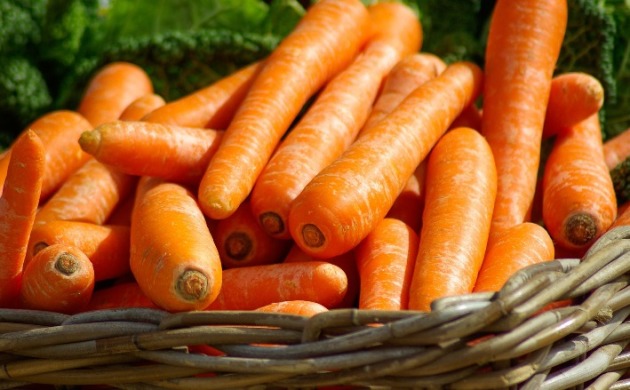
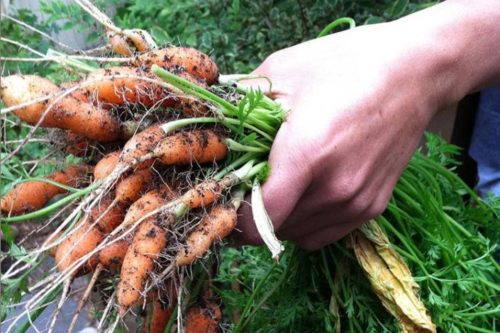
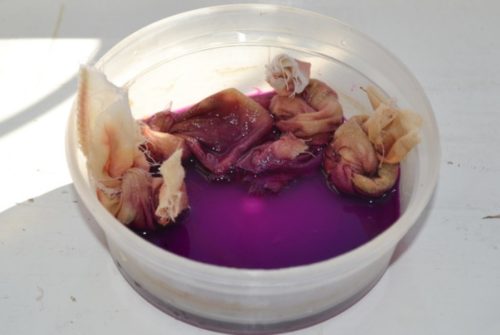
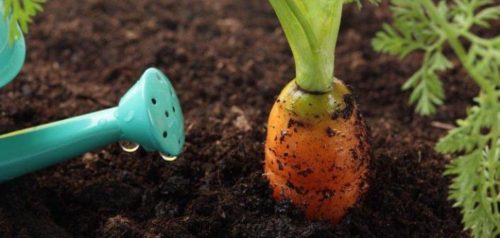
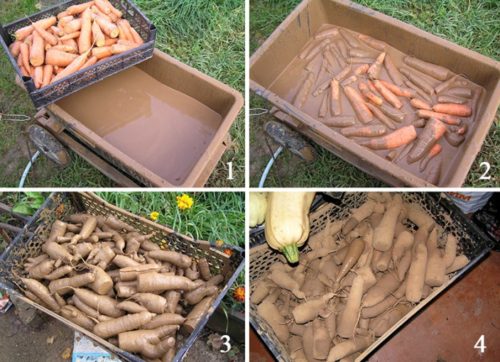












 Start a discussion ...
Start a discussion ...